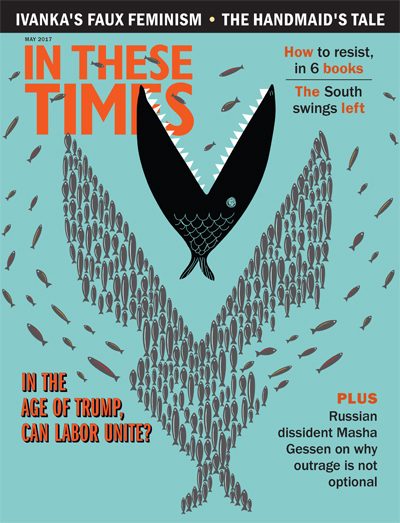
“Hola mis amores!” Melissa Hernandez, 35, calls out as she pulls her car up in a narrow alley between a muddy vacant lot and a tangle of brambles in Chicago’s North Lawndale neighborhood.
It’s the evening of Donald Trump’s inauguration, but that is a world away for the handful of people who emerge from a vacant building to greet Hernandez. They are Puerto Rican heroin users with health problems related to their addictions. Though several of them have spent time in the Cook County Jail and Mt. Sinai Hospital a few blocks away, they have been unable to get sustained treatment. Waiting lists at Illinois’ 40 private and 31 public methadone clinics and other treatment programs can be long, and poor people of color like the Puerto Rican users often have an especially hard time getting care because of language barriers, lack of insurance and IDs, and other social and economic issues. Hernandez fills the pockets and arms of each person with supplies: clean needles, bottled water, alcohol wipes, blankets and styrofoam containers of hot homemade Puerto Rican food. This is a taste of home for the many heroin users in the city’s alleys, abandoned buildings and flophouses she serves through her organization, the Puerto Rico Project.
Hernandez, a former user herself, knows how hard it is to find effective treatment. These days, in addition to working as a dental assistant, going to school and raising kids, Hernandez is constantly on the phone with Chicago treatment centers and public officials, trying to find beds for her clients.
A frail woman, wearing flip-flops despite the cold, walks slowly and painfully over to Hernandez, who greets her with a warm hug. She tells Hernandez that her hepatitis C has progressed, not to mention her HIV diagnosis. She says she no longer needs condoms since she is too weak to walk the streets.
The heroin epidemic has been a subject of growing public concern in recent years, Black and Latino heroin users are often absent from the discussion. Instead, media and policy attention has focused largely on white communities. There’s a reason for that: Nearly 90 percent of new users during the past decade were white. Heroin use among whites cuts across age and socioeconomic class; the drug has seeped into middle-class suburbs as well as poor, rural areas. In 2013, nearly 5,000 white people aged 18-44 died from heroin overdoses, representing a 517 percent increase from their rate of fatal overdoses in 2000.
Outside of the media spotlight, heroin remains a crisis in many Black and Latino communities. African Americans had the highest rate of fatal heroin overdoses in 2000, followed by Hispanics. The frequency of drug poisoning deaths has since more than doubled for both groups — an increase less dramatic than that of whites, but still of public concern.
The prevalence of opioids in white communities has helped motivate a new policy response. Many municipalities and court systems are opting to treat addiction as a public health issue, rather than a crime or individual moral failing. This is especially true in the Northeast (Vermont, New Hampshire, Massachusetts), where the epidemic has hit white communities hard. Experts and advocates welcome this shift in attitudes but lament that poor users and users of color still face many barriers to accessing treatment.
The other West Side story
Kathie Kane-Willis, founder of the Illinois Consortium on Drug Policy and current director of policy and advocacy at the Chicago Urban League, notes that while Chicago’s predominantly African-American West Side has become well-known as the place where young, suburban whites go to buy heroin, Black people are also using and dying there in high numbers.
In Illinois, Black people have significantly higher fatal overdose rates than white people, bucking national trends. The overdose mortality rate is 8.94 per 100,000 for Blacks, compared to 5.86 for whites, according to a 2015 study by the Consortium.
Kane-Willis points to a number of possible explanations for this outcome. One is a dramatic reduction in funding for public treatment programs in Illinois, even as the state has passed reforms such as drug court programs meant to divert users out of prison and into treatment. Public funding for addiction treatment programs in Illinois dropped from $111 million in 2007 to $79 million in 2012 — the steepest decline of any state during that period. The proposed 2016 budget, still pending as this story went to press, entails further deep cuts.
These cuts are devastating for users who can’t get into publicly funded programs and lack private insurance or other means to pay for private programs out-of-pocket. Blacks and Latinos are more likely than whites to rely on Medicaid, which did not cover methadone treatment in Illinois until 2015, when the state passed a sweeping “heroin bill.” Still, advocates worry that the low proposed reimbursement rates for methadone mean that many clinics will not accept Medicaid patients.
Experiences with police and the prison system may also influence some Blacks’ ability and willingness to seek treatment. Kane-Willis notes African Americans might be less likely to get naloxone, a drug that can reverse a heroin overdose, because fear of police retribution keeps them away from needle exchanges where the overdose drug is frequently distributed. Meanwhile, she notes that users are at high risk of overdose in the 72 hours after coming out of prison, if their tolerance has been reduced from time behind bars. Incarceration also often interrupts Medicaid coverage, meaning people have to reapply for the benefit.
Even when people of color do access treatment for heroin addiction, available studies suggest their success rate may be lower than that of whites. A 2013 paper published by the National Institutes of Health reported that minorities may be less likely to successfully complete treatment because they are more likely to live in environments with “high social distress, weak social support and few economic opportunities.” These factors can also make relapse more likely.
Take Reggie, a 53-year-old AfricanAmerican man for whom the criminal justice system, lack of economic opportunity and Chicago’s notorious public housing system all figure into a quarter-century of heroin addiction.
Reggie’s journey into addiction started with a series of personal tragedies. One day in May 1993, in the South Side public housing project where he grew up, Reggie went downstairs to find his younger brother — who had been selling marijuana in the basketball court — lying in a pool of blood. He had been shot. Reggie cradled him as he died. His brother had turned 18 a week earlier, and he left behind a fourmonth-old son. Reggie’s mother died later that year.
“I started to not care anymore,” he says. “Everything I cared about was gone.”
Reggie, then in his 30s, tried to kill himself with pills. Then he started drinking heavily and lived with friends “who partied 24-7.” Needing something stronger than alcohol, he tried heroin.
“In the projects heroin was everywhere,” he says. “I met this young lady, we started dating, she was into heroin. I decided to try it.”
Later, Reggie spent three months in Cook County Jail on charges related to his heroin use and suffered wrenching withdrawal symptoms.
“One minute it was like someone was going through my body with a flamethrower … the next minute it’s like I’m a block of ice shivering. I’d rather be shot than go through heroin withdrawal.”
After his release, Reggie went to a clinic on the city’s near North Side and got on a methadone regimen. But it didn’t work, in part because the methadone made him crave crack. He held down a job in the mail room of a downtown law firm until 2007, but all his money still went to heroin. Homeless, he now spends nights riding the trains or sleeping on Lower Wacker Drive, a subterranean maze of streets under downtown Chicago where older African-American heroin addicts live alongside young, white recent arrivals.
Reggie makes money for his fixes by panhandling. His skin is covered in pock marks; his hands are grotesquely swollen, a common symptom of heroin use. Reggie’s friend Jimmy, who is white, notes that white people are more likely to give money to Reggie, which means that he fares better. But earning enough to buy more heroin is no victory.
“I wish to God I’d never touched this,” Reggie says.
Harsh treatment
In addition to economic barriers, Latino heroin users seeking treatment may face language barriers and requirements to show ID, which many lack.
A handful of drug treatment centers in Chicago cater specifically to Spanish-speakers and Latinos, but there are never enough beds.
“One of the issues is education; sometimes they don’t know where to go,” says Marco Jacome, executive director of Healthcare Alternative Systems (HAS), a program founded four decades ago to serve Spanish-speaking alcoholics that now serves heroin users.
HAS has 16 beds in a short-term residential program and 16 beds in a transitional housing program where people can stay for up to a year. It also has 210 slots in an outpatient program that offers methadone, counseling and other behavioral services. Users attest that HAS has been an invaluable resource. But the need is greater.
In place of licensed centers catering to Spanish speakers, unlicensed treatment centers known as “24-hour groups” have sprung up in Latino neighborhoods across Chicago. Instead of providing medications, these groups rely on abstinence and a punitive, tough-love, quasi-religious approach.
Treatment consists mainly of marathon group therapy sessions during which people are insulted and humiliated, including by having their heads and eyebrows shaved.
The groups can be seen as part of a movement of grassroots treatment centers across Latin America. In Puerto Rico, such programs run by an organization called the Center for ReEducation of Addicts (Hogar CREA) make up about half the island’s total treatment centers, with 82 separate centers noted on a government list.
In 2015, journalist Adriana CardonaMaguigad revealed that Puerto Rican municipal agencies and state police have long been sending addicts from the island to the unregulated 24-hour groups in Chicago, where they suffer verbal and sometimes physical abuse and live in often squalid conditions. Their IDs are sometimes stolen and presumably sold, and their public aid benefits are confiscated.
Many of the people Melissa Hernandez serves fled from these groups. She has documented the deaths of two men who came from Puerto Rico to these treatment centers and overdosed on Chicago’s South Side; in fact, she and Cardona-Maguigad stumbled upon one of the bodies. Hernandez is determined to see the groups regulated, with licensed private and public institutions expanding to fill the gap.
But such an expansion in services is unlikely to happen soon, especially with an ongoing budget crisis in Illinois and President Trump’s promise to slash social services.
In the meantime, Hernandez continues to demand better for the people she helps. “I’ve seen, witnessed, heard about a lot of setbacks and challenges,” she says. “No ID, no this, no that. But let’s just get someone in a program and help them.”
Kari Lydersen is a Chicago-based journalist, author and assistant professor at Northwestern University, where she leads the investigative specialization at the Medill School of Journalism, Media, Integrated Marketing Communications. Her books include Mayor 1%: Rahm Emanuel and the Rise of Chicago’s 99%.









